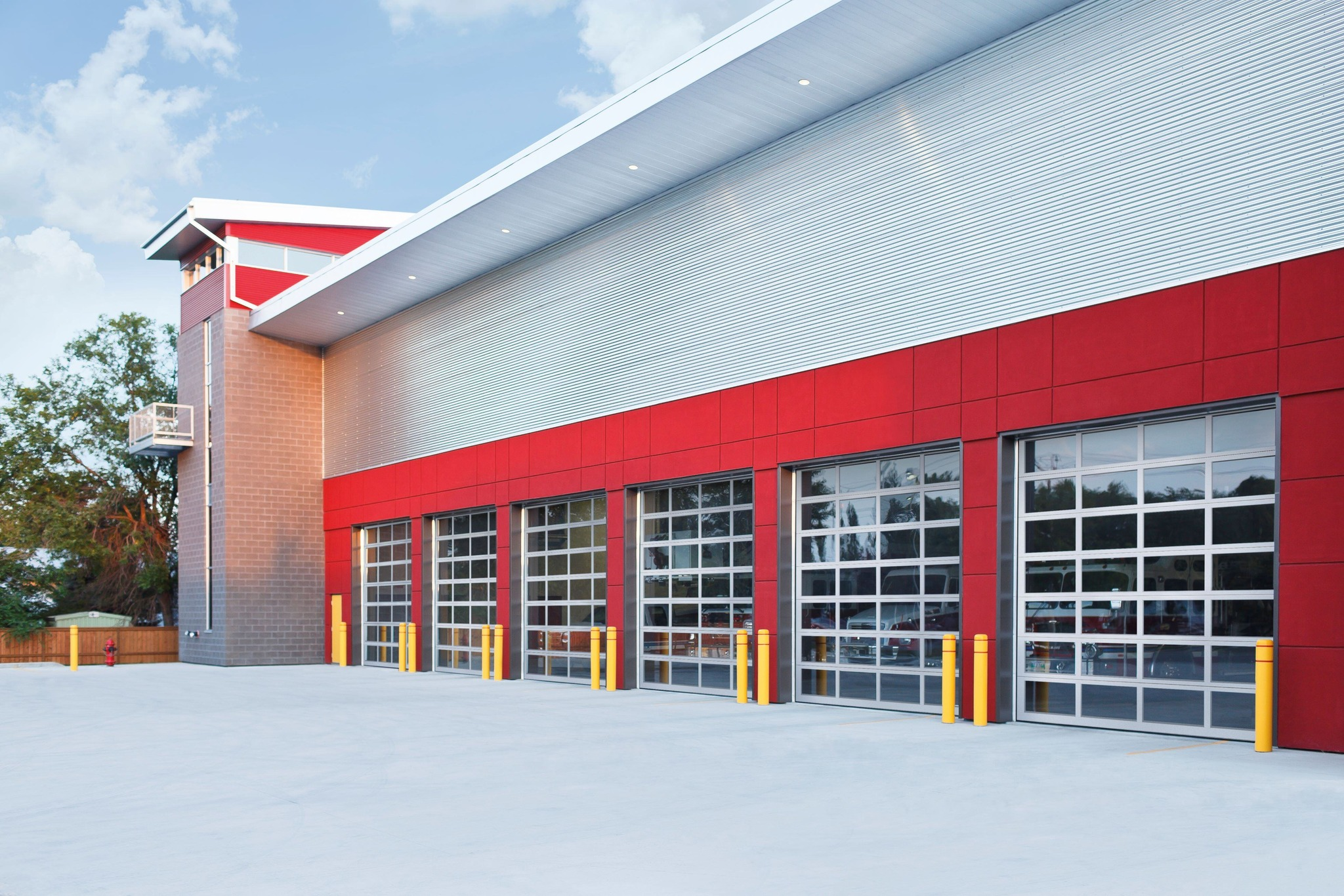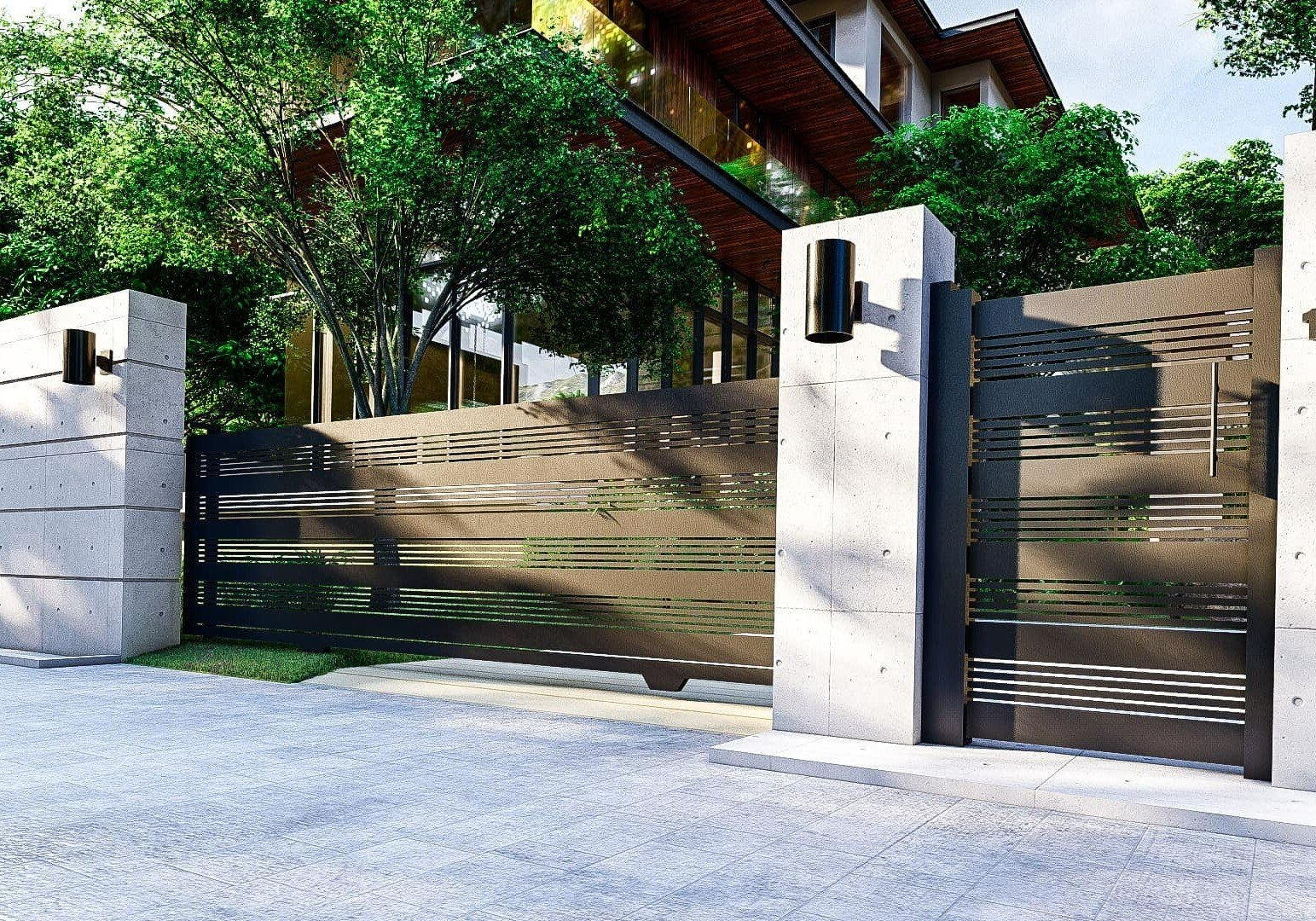-
UL 325 safety requirements
UL 325 mandates that all automated swinging gates include at least two independent entrapment protection devices. These can include:
- Photoelectric sensors (Type B1): detect objects without contact
- Safety edges (Type B2): installed to stop or reverse motion upon contact
- Inherent force sensing (Type A): reverses gate when excessive force is detected
If a swinging gate operates toward a wall or post, a safety edge must be installed on the leading edge to reduce crushing risk. Gates must also reverse within two seconds upon detecting an obstruction. Clearly visible signage is required, such as “Pedestrians must use separate entrance.”
-
ASTM F2200 gate construction and structural compliance
ASTM F2200 specifies physical construction requirements for swinging gates, including:
- No openings greater than 2.25 inches in the gate frame to prevent entrapment
- No horizontal bars or footholds to deter climbing
- Elimination of protruding components or sharp edges that could cause injury
- Gate design must accommodate wind loads and be balanced for safe movement
Gates installed with dual panels may require intermediate safety edges or sensors to address entrapment between the panels.
Installation and clearance practices
- Gates must be installed with sufficient clearance from fixed objects such as walls, posts, and fences to avoid pinch points.
- Barriers or bollards should be used to restrict access where swing paths intersect pedestrian or vehicle routes.
- Control devices must be placed at least 6 feet from moving parts and outside the gate’s swing radius.
In addition to an automatic gate operator, manual release mechanisms must be present, clearly marked, and accessible for emergency operation.
-
Routine maintenance and inspection
Ongoing safety and compliance require regular maintenance and testing by trained professionals. UL 325 mandates annual safety inspections, but maintenance frequency should be based on usage levels:
- High-traffic environments: Quarterly maintenance
- Medium-traffic environments: Semi-annual maintenance
- Low-traffic residential gates: Annual inspection at minimum
Service checks should include testing all sensors, verifying force reversal functions, inspecting signage, and checking mechanical wear. Preventative maintenance not only ensures continued compliance but helps reduce the risk of unexpected failures and liability.
UL 325 compliance for rolling and sectional overhead doors
Whether rolling steel doors or sectional doors, motorized overhead doors are commonly used in commercial, industrial, and residential settings. Due to their size, weight, and powered operation, these doors present potential entrapment and impact hazards. UL 325 provides the primary safety framework, detailing requirements for safety devices, control placement, emergency operation, and user warning systems.
-
Entrapment protection requirements
UL 325 requires that all automated overhead doors be equipped with at least two independent entrapment protection systems to reduce the risk of injury or obstruction-related damage. The first is typically an inherent force-sensing system, which detects resistance during operation and causes the door to stop or reverse if it encounters an obstruction. The second must be an external safety device, such as one of the following:
- Photoelectric sensors (photo eyes) that detect objects in the path without requiring contact
- Safety edges mounted along the bottom of the door that trigger reversal when contact is made
- Constant pressure controls, used in certain industrial environments where automatic reversal is not practical
All safety systems must be tested and verified for functionality during initial installation and as part of routine maintenance to ensure continued compliance and user protection.
-
Operational safety and signage
UL 325 requires all overhead doors to include a manual disconnect mechanism that allows emergency operation in the event of a power failure or system malfunction. Wall-mounted control stations must be placed within the line of sight of the door and at least 5 feet above the floor to prevent accidental activation, particularly by children. Remote and wireless control systems must include built-in security features to guard against unauthorized use or interference.
In addition to control safety, clear and permanent signage is a critical compliance component. Overhead door systems must display warning labels that instruct users not to walk under a moving door and provide manufacturer certifications confirming that the operator meets UL 325 standards. These signs must be durable, clearly visible, and unobstructed at all times.
Best practices
To maintain long-term compliance and ensure safety, the following best practices are recommended:
- Install two entrapment protection devices, including at least one external sensor
- Test all safety systems during installation and routine maintenance
- Place controls and signage according to UL 325 guidelines
- Train end users on safe operation and emergency procedures
-
Preventative maintenance and inspection
Ongoing safety depends on regular, professional service. UL 325 requires annual inspections, though the ideal frequency depends on usage:
- High-traffic locations (warehouses, garages, delivery bays): Quarterly service
- Medium-traffic sites (retail stores, commercial garages): Semi-annual service
- Low-traffic residential use: Annual inspection and maintenance
Each visit should include sensor testing, force calibration, control verification, and inspection of mechanical components. Preventative maintenance not only ensures continued compliance but helps reduce downtime, minimize liability, and extend the life of the system.
UL 325 & ASTM F2200 compliance for automated sliding gates
Sliding gates operate along a linear path and often run parallel to fences or other fixed structures, creating unique safety challenges not found in other automated systems. To mitigate these hazards, UL 325 and ASTM F2200 require strict adherence to both operator safety and physical construction standards.
-
UL 325 & ASTM F2200 overview
UL 325 is the primary safety standard regulating the operation of automatic sliding doors, with a focus on minimizing entrapment risks during movement.
UL 325 requirements for sliding gates include:
- Two independent entrapment protection devices (e.g., photo eyes, safety edges, force sensors)
- Automatic reversal within 2 seconds of detecting an obstruction
- Manual disconnect for emergency operation
- Signage stating: “Pedestrians must use separate entrance”
-
Construction standards
ASTM F2200 complements UL 325 by establishing construction standards that reduce physical hazards associated with sliding gate movement.
ASTM F2200 design requirements include:
- Gate openings no larger than 2.25 inches
- No horizontal bars or footholds that allow climbing
- Moving parts must be shielded to prevent pinch or shear injuries
- Fixed panels or screens required to restrict access to gate movement path
-
Fixed barrier panels for sliding gates
ASTM F2200 requires the use of fixed barrier panels in situations where entrapment hazards may occur, particularly where a sliding gate moves parallel to a fence, wall, or other fixed object. These panels are intended to prevent individuals from accessing the gate’s movement path and reduce the risk of crush injuries or pinch points between the moving gate and stationary structures.
Key requirements for fixed barrier panels
- Gates must be designed to prevent entrapment between the gate and fixed objects such as fences or walls
- If a gap smaller than 2.25 inches exists between the gate and a nearby structure, a fixed guard panel or fence must be installed
- Any openings in the gate or protective screen must not allow a 2.25-inch sphere to pass through
- A stationary panel or screen should cover the gate’s entire travel path to restrict pedestrian access to the track area
-
Best practices and preventative maintenance
Achieving full compliance with UL 325 and ASTM F2200 for sliding gates requires careful planning and regular servicing. Adhering to a set of best practices helps minimize risk and ensure that all safety mechanisms function as intended:
- Install two entrapment protection devices, such as photoelectric sensors and safety edges
- Place gate controls at least 6 feet from moving parts to prevent accidental or unauthorized operation
- Use fixed barrier panels to restrict access to hazardous areas, especially near the gate’s track path
- Post visible signage warning pedestrians to use separate entrances
- Provide user training on safe operation and emergency procedures
Routine preventative maintenance is essential to keep gate systems operating safely over time. UL 325 requires annual safety inspections, but the optimal maintenance schedule depends on how frequently the gate is used:
- High-traffic areas (e.g., commercial, industrial, gated communities): Quarterly service
- Medium-traffic environments (e.g., office buildings, apartments): Semi-annual service
- Low-traffic or residential gates: Annual inspection to meet minimum compliance
Each service visit should include testing of safety devices, inspection of mechanical components, checking for wear on the operator and track, and verification of signage and barrier integrity.



San Diego:
9185 Chesapeake Dr.
San Diego, CA 92123
(858) 925-2700
Mission Viejo:
27281 Las Ramblas, Suite 200,
Mission Viejo, CA 92691
(949) 749-7665
Email:
info@radforddoors.com
Google Rating
4.9